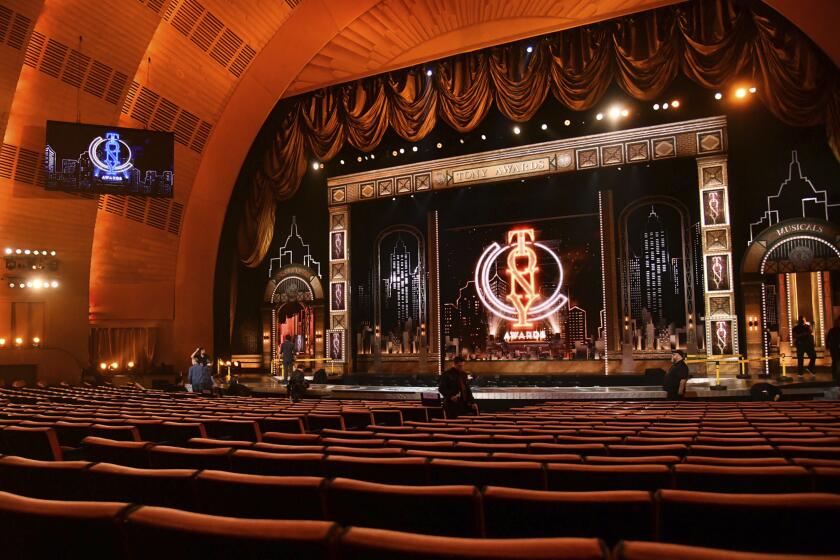Try it -- it’s good for you
- Share via
To mark its 30th birthday, “Live From Lincoln Center” has assembled a two-hour compendium of greatest hits that will air Thursday night on PBS. It takes the “live” in its title seriously: None of these clips have been seen since they were first broadcast.
It is perhaps quaint and quixotic of me to think so, but even at this late date and against much evidence to the contrary, I still regard television as a tool to enrich the society, to bolster the health of the nation and ensure the future of the world by bringing the best, the brightest and the brightest-burning into your living room, where they may inspire you to improve yourself, and your children to achieve great things.
That, for the most part, television seems disinclined to take up this challenge is not my fault. That it is not a silver platter distributing the world’s great delicacies and deep achievements for all to enjoy, but a steam shovel giving the people as much as it possibly can of what it has been scientifically determined that the people want, is something I can do nothing about.
Of course, there is a democratic logic in the way TV runs -- or a market logic, which to the American mind is essentially the same thing -- that says what the people want is by definition what’s good for the people. But the McDonald’s Effect proves this false, since what the people want is sugar and fat and other things that are demonstrably no good for them, and this metaphor is extensible to TV and beyond. What’s good for the people is spinach and cauliflower, tastes the educated or open palate understands are also delicious. Even public TV, which has been constrained to run around with an increasingly bigger hat in hand to offset the shortfall from government funding, and to defend itself from charges of elitism now caters to its audience rather than, like the liberal-arts institution it should be, surprising and educating them. Still, its self-selected viewership puts a premium on what we call “culture,” and understands that without a little elitism nothing moves forward.
Indeed, the society seems increasingly resistant as a whole to the idea that there is a high culture that if not superior to pop culture offers flavors not available there, flavors more rare and complex. It seems to me that when I was a child, the idea that there was not only such a thing as high art, but that it could make you a better person to know about it, was not only taken for granted but actively promoted -- and promoted in part through television -- so that without even being particularly interested in opera or dance, but spending a decent time in front of the tube, one became familiar with the era’s stars of classical music and dance. (And this was in a time before 500 channels.)
It was in those years that Lincoln Center opened, and our own Music Center, both built on the lines of the Acropolis -- multi-temple compounds to art and culture. The New York Philharmonic, the Metropolitan Opera, New York City Ballet and New York City Opera have all called Lincoln Center home, and it has its jazz and film programs as well, and some of all of that is seen here (getting back to the program at hand). It’s just a clip show, but -- despite a little conceptual corniness in some of the framing devices -- a good one, and like most good clip shows, it marshals the power of history and the power of excellence to satisfy the initiate and sway the novice.
As with the programming of classical music seasons (which, like public TV, also run on grants and subscription), there is a tendency here to play to the popular favorites, both as regards material and performers, but there is plenty of remarkable stuff on display within those bounds. Isaac Stern and Itzhak Perlman perform the Bach Double Violin Concerto; Andre Watts goes to town on “Rhapsody in Blue”; Beverly Sills twitters astonishingly some Rossini. You get Yo-Yo Ma and Joshua Bell and Placido Domingo. There are a little tribute to George Balanchine in which are seen Mikhail Baryshnikov, Peter Martins and Suzanne Farrell; a deftly edited medley of piano concerti (mostly Beethoven) that includes Van Cliburn, Claudio Arrau, Emanuel Ax, Murray Perahia, Daniel Barenboim, Rudolf Serkin and Alfred Brendel; and another of performances of “La ci darem la mano” from “Don Giovanni,” sung in turn by Renee Fleming, Frederica von Stade, Francesca Pedaci, Cheryl Parrish, Kathleen Battle and Mariella Devia.
The conservative programming choices -- there is no Ornette Coleman or Elliott Carter or even Philip Glass, though they’ve all been live at Lincoln Center -- run sometimes near to the point of kitsch. And yet even in these moments -- Perlman rendering the theme from “Schindler’s List,” Irish flute icon James Galway playing “Danny Boy” -- you get a jolt of the thrilling control of tone and volume and phrasing, the combination of high coordination and deep consciousness that separates the titans from the tootlers. There is some actual pop here too: “Send in the Clowns,” sung by Sally Ann Howes; Wynton Marsalis (who directs Lincoln Center’s jazz program) in a couple of settings; and a number from the “dance play” “Contact,” which runs on at a length made less bewildering by the fact that it originated at Lincoln Center.
Not least there is Danny Kaye, conducting the New York Philharmonic. And Luciano Pavarotti, who has become almost the comic incarnation of the Opera Singer, is seen to have been no joke. He starts the show, and ends it, magnificently, and darned if I didn’t feel a little more wholly human for having heard him.
*
‘A Lincoln Center Special’
‘30 Years of Live From Lincoln Center’
Where: KCET
When: 8 to 10 p.m. Thursday
Ratings: TV-G (suitable for all ages)
More to Read
The complete guide to home viewing
Get Screen Gab for everything about the TV shows and streaming movies everyone’s talking about.
You may occasionally receive promotional content from the Los Angeles Times.







